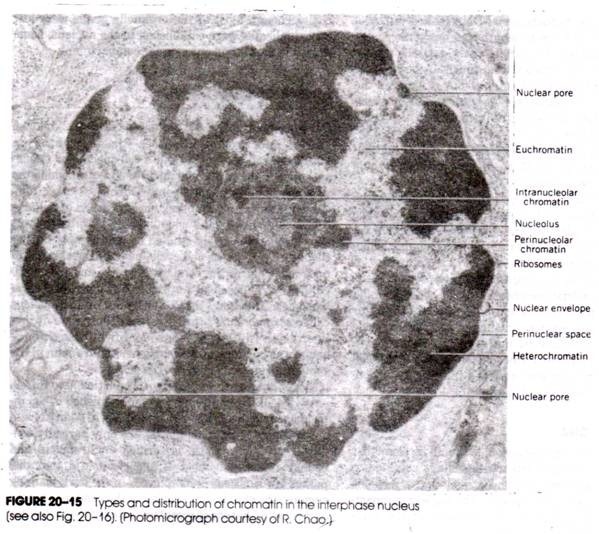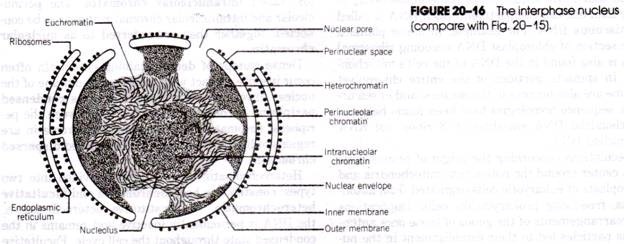ADVERTISEMENTS:
The nucleolus is the dominant internal feature of the cell nucleus and was among the first subcellular organelles described by microscopy (by Fontona in 1774).
The nucleolus is not separated from the remaining nucleoplasm by a membrane, but in many cells its margins are associated with chromatin (i.e., the perinucleolar chromatin, see Figs. 20-15 and 20-16).
The nucleolus is composed of RNA and proteins and is the site of formation of ribosomal constituents.
ADVERTISEMENTS:
In cells that are actively engaged in protein synthesis and which therefore have greater demands for ribosomes, the nucleoli are larger and more numerous.
When the cell undergoes nuclear division, protein synthesis is decreased and ribosome production is halted. These changes are accompanied by a reduction in the size and number of nucleoli. In fact, at the metaphase stage of mitosis, no nucleoli can be distinguished.
ADVERTISEMENTS:
Parts of one or more chromosomes are looped into a nucleolus forming what is known as a nucleolar organizing region (NOR). These regions contain the genes that are transcribed into rRNA. Dense fibrillar regions surrounding the NOR are associated with small ribonucleoprotein particles and frequently reveal mature ribosomes.
The Nuclear Envelope:
The presence of a membrane separating the contents of the nucleus from the surrounding cytosol is one of the principal characteristics distinguishing eukaryotic organisms from prokaryotic organisms. The existence of a membrane delimiting the nucleus was first demonstrated by O. Hertwig in 1893. However, little interest was shown in studying this membrane until electron microscopy revealed that it was not simply a single membrane, but rather a double membrane in which the outer membrane had features that clearly distinguished it from the inner membrane.
The two membranes are concentric and separated by a small space (called the perinuclear space) varying in size from about 10 to 50 nm; collectively, the two membranes form the nuclear envelope. A fibrous material called the lamina densa lies just under the inner nuclear membrane and is believed to give structural support to the envelope and also provide anchorage for the condensed peripheral heterochromatin. The inner and outer nuclear membranes fuse together at the margins of the nuclear pores (Figs. 20-15 and 20-16).
The functions of the nuclear envelope are diverse. Clearly, it serves to compartmentalize the nucleoplasm, acting as a barrier to the .movement of large subcellular components between the nucleus and the cytosol. However, ribosome precursors from the nucleolus and mRNA and tRNA molecules do exit the nucleus through the nuclear pores. Molecules also enter the nucleus from the cytoplasm, triggering a number of nucleocytoplasmic interactions.
The nuclear envelope is not just a physical barrier, but functions also in connection with cellular activities taking place on either side. Ribosomes may be attached to the cytosol face of the outer nuclear membrane, which thereby takes on a structural appearance like rough endoplasmic reticulum; indeed, the outer membrane may have periodic continuities with the endoplasmic reticulum. The intimate relationship between the nuclear membranes and the endoplasmic reticulum is not surprising because a new nuclear envelope forms at the end of mitosis by the coalescence of membranes of the endoplasmic reticulum.
The inner membrane of the nuclear envelope may have special functions associated with the chromosomes. As noted earlier, in the interphase nuclei of many cells, heterochromatin is closely appressed to the inner membrane.
This association does not occur at the nuclear pores; instead, the chromosomes seem to be firmly attached to the inter-pore areas. The role of the association between chromatin and the nuclear envelope is unclear but may be related to chromosome replication and orientation during interphase and the early prophase of mitosis and meiosis.
Some materials such as ribonucleoprotein particles are exchanged between the nucleoplasm and the cytosol through open nuclear pores. However, the nuclear pores are not the only avenues for nucleocytoplasmic exchanges (Fig. 20-17). For example, small molecules and ions readily permeate both nuclear membranes. Larger molecules and particles may pass through the membrane by formation of small pockets and vesicles that traverse and envelope and empty on the other side.
Although many cellular membranes contain pores, the pores of the nuclear envelope are more complex and possess a special character because they are openings formed by the fusion of two membranes (Fig. 20- 18). The number of nuclear pores varies widely among different cells but, in general, ranges from 1 to about 60 pores per square micrometer of membrane.
The orifice is essentially circular, with occasional evidence of a polygonal shape. Seen in freeze-fractured preparations, the pores appear as rings and therefore are called annuli. Although the inside diameter of an annulus varies over a narrow range among different cells (i.e., 60 to 100 nm), it is markedly constant for a given cell type.
The rim of the pore contains eight granular sub- units symmetrically placed about the circumference (Fig. 20-19). The center of the pore often contains distinct substructures such as conical projections from the sides into the center. More often than not the lumen of the pore is filled with “annular material” that projects into both the nucleoplasm and cytoplasm, often flowing radially beyond the pore rim.





